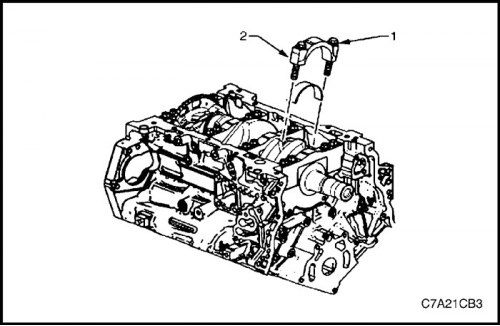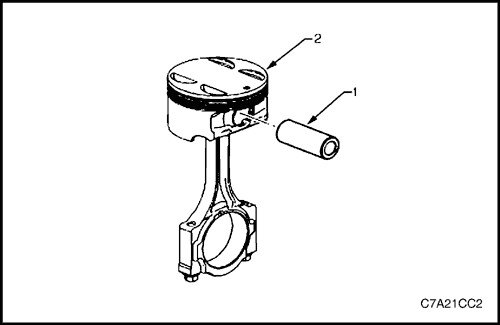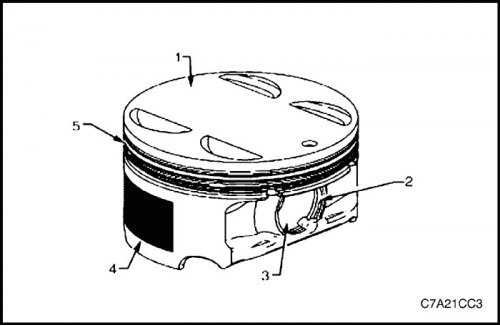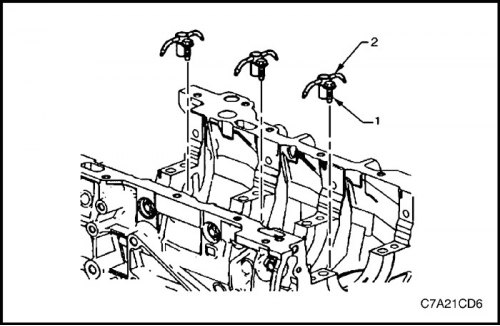Removal procedure
1. Dismantle the engine assembly. follow the paragraph «Complete engine» in this section.
2. Remove both cylinder heads as an assembly. See «Cylinder head block» in this section.
3. Remove the oil pan assembly. See «oil pan» and «Suction pipe of the oil pump assy» in this section.
4. Mark the top of the piston to be removed, indicating in which cylinder it is located.
5. Install on crankshaft (2) fixture EN-46111 (1).
6. Turn the crankshaft so that the piston to be removed is at the bottom of the stroke - at bottom dead center (NMT).

Attention! If the connecting rod bearings were used with the engine running, they must be replaced with new ones during subsequent assembly.
7. Before removing the connecting rods, check the side clearance of the connecting rods, proceeding in the following sequence.
A. With light blows with a hammer made of wood or other soft material, move the connecting rod along the crankshaft journal to the end.
B. Use a feeler gauge to measure the clearance between the crankshaft counterweight and connecting rod.
C. Connecting rod side clearance must not exceed the specification.
D. If the end play is greater than the specification, measure the width of the big end of the connecting rod.
E. If the width of the big end of the connecting rod is significantly less than the required value, and the side surface of the connecting rod is badly worn, replace the connecting rod.
F. If the connecting rod width is within specification and there are many scratches on the crankpins, replace the crankshaft.
Attention! Do not use a punch, punch, or any other tool that could damage or stress the connecting rod and end cap. A bent or stressed connecting rod can cause significant engine damage.
8. Use a felt-tip pen to write the cylinder number on the connecting rod and on the connecting rod head cover.
Attention! Bolts of connecting rods made of powdered metal are plastically deformed when tightened to the required torque. If these bolts are loose or removed, they must be replaced. If the connecting rod bolts are not replaced, they cannot be tightened to the required torque, which can lead to serious engine damage.
9. Remove connecting rod bolts (1), releasing them gradually and one by one.
Attention! Connecting rod caps must be used without changing to other connecting rods.
10. Remove cover (2) connecting rod heads.

11. Install EN-46121 rail kit (1) for the connecting rod into the bolt holes.

Attention! When removing the connecting rod and piston assembly, care must be taken not to damage the crankshaft journal, cylinder wall, and piston cooling nozzles.
12. Using the EN-46121 rail kit (1), push out the connecting rod and piston assembly (2) through the top of the cylinder.

Attention! When disassembling, it is necessary to maintain the original location of the connecting rod, connecting rod head cap, piston and bearings. It will also help in diagnosing the condition of the mechanical part of the engine.
13. Remove EN-46121 rail kit (1) for connecting rod from bolt holes.
14. Remove the upper bearing shell of the big end of the connecting rod (2).

15. Remove lower bearing (1) lids (2) big connecting rod head.

16. Install cover (1) connecting rod to connecting rod (2), to avoid damaging their interfaces.
Note: The cap and connecting rod are matched and should be stored together.
17. Repeat operations from 4th to 16th for the rest of the connecting rod and piston groups.

Disassembly
Attention! Special pliers must be used to remove and install piston rings. It is necessary to expand the rings during installation just enough to be able to pass the piston bridge between the piston grooves. With excessive expansion of the rings, the upper ring will be destroyed, and the rest will be deformed.
1. With the help of pliers (1) remove piston rings (2). Store each ring in a clean tissue.

Attention! Piston pin retainers must not be reused.
2. Remove the piston pin retainers using the cutout (1), available on the side of the piston. Discard the piston pin retainers.

3. Pull out the piston pin (1) from a piston (2). The piston will separate from the connecting rod.

Verification procedure
1. Inspect the pistons for the following faults.
- Are there any eroded places on the piston bottom (1).
- Are there any joints in the grooves for the piston pin retainers (2).
- Are the piston pin bores and piston pins worn? (3).
- Is the piston skirt coating scratched or damaged? (4).
- Are the ring grooves cracked or dented or scored that could cause seizing? (5).
- Are the bridges between the piston ring grooves not bent or worn?
2. Replace pistons that show any signs of damage or excessive wear.

3. Measure the piston width using the following procedure.
- Using an external micrometer, measure the piston width at the piston bearing surface, perpendicular to the piston pin centerline.
- Compare the measurement result of the piston with its size in the original cylinder, subtracting the piston width from the cylinder diameter.
- If the clearance obtained as a result of the measurement is greater than specified by the norm, and the cylinder bore is within the norm, it is necessary to replace the piston.

4. Measure clearances between piston pin bore and piston pin (2), using the following procedure.
- Piston pin bores and pins must be free of deposits and burrs.
- Use an external micrometer to measure the piston pins in the areas of the contact surface with the pistons (1).

- Using an internal micrometer, measure the piston pin bore (1). Compare the result with the piston pin diameter and the clearance between the piston pin and the piston pin bore. follow the paragraph «Engine Specifications» in this section.
- If the clearance is too large, determine which part is out of specification and replace if necessary.
- Replace piston if any of its dimensions are out of specification.
- If the new piston does not meet the standard clearance, then the cylinder can be bored out by 0.25 mm. For maintenance, only one repair size of pistons and rings is provided.

5. Measure the piston ring end clearance using the following procedure.
- Piston pin bores and pins must be free of deposits and burrs.
- Place piston ring (1) into the hole in which it will move, approximately 25 mm below the surface of the cylinder block plate. Make sure the ring is at right angles to the cylinder bore by setting the ring position with the piston head.
- Measure the end clearance of the piston ring using gap gauges (2).
- If the clearance exceeds the stipulated limits, it is necessary to replace the piston rings.
- Repeat the procedure for all piston rings.

6. Measure the piston ring backlash using the following procedure.
- Fully insert the piston ring into the piston groove. If ring sticking is caused by a piston groove, file the groove with a fine file. If the seizing is due to deformation of the piston ring, the ring must be replaced.
- After installing the piston ring on the piston, check the gaps in several places using feeler gauges.
- Compare measurements with piston ring backlash. follow the paragraph «Engine Specifications» in this section.
- If the clearance is greater than specified, the piston rings must be replaced.
- If with the help of a new ring it is not possible to reduce the gap and reach the standard, then a new piston must be installed.
- If it is not possible to achieve the specified clearance with the new piston, then the size of the cylinder block must be increased by 0.25 mm. There is only one oversized piston and ring available for service.

7. Check the connecting rods as follows.
- Inspect bushing (4) piston pin, checking for scratches or damage.
- Check for twisting or bending of the connecting rod (1).
- Check if there is any on the lid (2) connecting rod dents or damage due to possible interference.
- Check the bearing surface of the connecting rod bearing for scratches or abrasions.
- If there are minor scratches and abrasion marks on the connecting rod holes, clean the holes around the circumference with fine sandpaper.
- Temporarily install old bolts (3). They must be replaced during the final installation.

8. Measure the clearance between the piston pin hole of the connecting rod and the piston pin using the following procedures.
- With external micrometer (1) take two piston pin measurements (2) in the area of the connecting rod.

- Using an internal micrometer, measure the connecting rod piston pin bore (1).
- Subtract the piston pin diameter from the piston pin bore.
- Compare gap measurements. follow the paragraph «Engine Specifications» in this section.
- If the clearance is too large, replace the piston pin. If a new pin does not resolve the clearance problem, the connecting rod will need to be replaced.

9. Measure the connecting rod main bearing bore (1) using the following procedures.
- Using an internal micrometer, measure the connecting rod main bearing bore.
- Compare hole measurements. follow the paragraph «Engine Specifications» in this section.
- If the hole is out of specification, replace the connecting rod. Do not repair connecting rod.

10. Check the surface of the cylinder block plate for flatness using a straight edge and feeler gauge. follow the paragraph «Engine Specifications» in this section.
11. Check the bearing bore for concentricity and alignment using the J-8087 Cylinder Bore Gauge, Follow step «Engine Specifications» in this section. If the bearing bore is out of specification, replace the cylinder block.
12. Check the cylinder block bore for wear, runout and taper using a bore gauge. follow the paragraph «Engine Specifications» in this section.
13. Check the polishing of the cylinder block bore. Lightly hone the cylinder bore if necessary.

Assembly
Piston and piston pin
Attention! The arrow on the piston crown must point towards the front of the engine.
Note: There is no specific direction for the connecting rod and it can be connected to the piston in any orientation.
1. Lubricate piston pin bores (1) in the piston (2) and connecting rod with clean engine oil.
2. Connect the piston to the connecting rod with the piston pin. When reusing a marked connecting rod, the piston must be correctly oriented.
3. Align the piston pin holes in the piston and connecting rod.
4. Insert piston pin into piston and connecting rod.

Attention! New piston pin retainers must be used. Piston pin retainers must not be reused.
5. Install new fasteners (1) piston pin.
6. Make sure the piston pin retainers are fully seated in the grooves.
7. Repeat steps 1 to 6 for the rest of the pistons.

Piston ring
1. Before installation, it is necessary to correctly orient the expander (1) oil rings. The ends of the expander should be directed towards the bottom of the piston.

2. Using piston ring pliers, install the oil scraper rings according to the following instructions:
A. Install expansion ring (3).
b. Install top and bottom discs (4) oil scraper ring. Expand the ring just enough to pass the piston diameter. Excessive expansion of the piston rings will cause them to deform or break.
3. Install second (2) and top (1) piston rings in the following order:

4. With the help of pliers (1) install the second piston ring (2) on the piston (3). Do not push the ring too far. Repeat this operation for the top ring.

5. After installing the rings, position the locks of the rings as follows. The arrow on the piston should be used as a reference line.
- The position of the lower oil scraper ring (1).
- The position of the upper oil scraper ring (2).
- Top ring position (3).
- Oil scraper ring expander position (4).
- Position of the second ring (5).

connecting rod bearing
Attention! If the connecting rod bearings were used with the engine running, they must be replaced with new ones during subsequent assembly.
1. Wipe with a cloth that does not leave lint and threads, the hole for the bearing shells in the connecting rod (2) and connecting rod cover.
2. Clean the bearing shells of the lower head of the connecting rod from oil.
3. Install new upper bearing shell (1). Rotate the liner so that its antennae is located in the groove of the connecting rod. The liner must be located in the connecting rod, not protruding outward.

4. Install the lower bearing (1) on the lid (2) connecting rod.
5. Rotate the liner so that its antennae is located in the groove of the connecting rod. The liner must be located in the connecting rod cap without protruding outward.

Installation procedure
Connecting rod installation with connecting rod bearing
1. Lubricate the cylinder bore, piston rings and piston skirt liberally with engine oil.
Attention! The piston has a specific orientation that must be ensured when it is installed in the cylinder block. The arrow on the bottom of each piston must point towards the front of the engine.
2. For the cylinder, it is necessary to use only a connecting rod and piston group that has the same number as the cylinder. Dot indicates correct orientation (1), located on the bottom of the cylinder.

3. Install EN-46121 rail kit (1) for the connecting rod into the bolt holes.

4. Compress the piston rings with a standard mandrel.
Attention! When installing the connecting rod and piston group, extreme care must be taken not to damage the cylinder bore, oil nozzles or crankshaft surfaces.
5. Slowly insert the piston (2) and the connecting rod assembly into the cylinder, holding them with one hand from the top of the cylinder, and with the other from the bottom. Contact of the connecting rod with the cylinder mirror is not allowed.
6. When the mandrel of the piston rings rests against the surface of the cylinder block, insert the piston into the cylinder, lightly tapping it with a soft hammer handle. Using guide pins EN-46121 (1), direct the connecting rod to the crankshaft journal, while lightly moving the piston along the cylinder with a soft hammer.

7. Remove EN-46121 rail kit (1) for connecting rod from bolt holes.

Connecting rod bearing clearance measurement
Note: Clearances in new connecting rod bearings must be checked before final assembly.
1. Lay a piece of new calibrated plastic wire at room temperature along the entire length of the crankpin.
2. Install the connecting rod bearing into the connecting rod cap.
3. Install cover (1) connecting rod onto the connecting rod and make sure that the tabs of the bearing shells are located on one side of the connecting rod.

Note: The old connecting rod bolts can be used to measure the connecting rod bearing clearance.
4. Install the connecting rod cap bolts.
Tighten
Tighten the bolts to 30 Nm (22 lb-ft), and then completely loosen the bolts. Tighten connecting rod cap bolts to 25 Nm (18 lb-ft) and turn the bolts another 110°using the angle torque indicator KM-470-B.
5. Leave the assembly in this state for at least 2 minutes.
6. Remove the connecting rod cap bolts and discard them.
7. Remove the connecting rod cover.
8. Determine the clearance in the connecting rod bearing by comparing the width of the flattened plastic wire (1) at the widest point with the scale on the gauge wire package (2).
9. Compare the measurement result with the specifications.
10. If the new bearings do not provide the required clearance with the crankshaft, then check the following:
- A. Measure the crankshaft crankpins to determine if they are the correct size and ensure that the required new bearings are used. If the dimensions of the connecting rod journals of the crankshaft differ from those required, then replace or grind the crankshaft. Machining of the crankshaft is allowed and for this case oversized bearings are provided.
- b. Measure the diameter of the bearing bore in the connecting rod to make sure it is the correct size. The connecting rod is not machined and if it is out of specification, the connecting rod must be replaced.
11. Clean plastic wire from connecting rod journals with a lint- and thread-free cloth.

Connecting rod final installation procedure
1. Carefully move the connecting rod slightly away from the crankshaft journal to lubricate the surface of the crankshaft journal that the connecting rod bearing contacts.
2. Liberally lubricate the surface of the crankshaft journal that the connecting rod bearing contacts with clean engine oil.
3. Position the connecting rod on the crankshaft journal.
4. Install cover (1) connecting rod onto the connecting rod and make sure that the tabs of the bearing shells are located on one side of the connecting rod.
Attention!
- Do not lubricate new connecting rod cap bolts. New bolts are already lubricated with graphite grease. Lubricating the connecting rod bolts will create internal hydraulic pressure when the bolts are torqued. Unintended hydraulic pressure can destroy structural components and cause significant engine damage.
- Do not use old connecting rod cap bolts.
5. Install new connecting rod cap bolts.
Tighten
Tighten the bolts to 30 Nm (22 lb-ft), and then completely loosen the bolts. Tighten connecting rod cap bolts to 25 Nm (18 lb-ft) and turn the bolts another 110°using the angle torque indicator KM-470-B.
Note: During and after installation, ensure that the pistons are in the correct position and orientation in the cylinders. The arrow on the bottom of each piston must point towards the front of the engine.
6. Repeat the described operations for the rest of the connecting rod and piston groups.
7. Install the oil pan and oil pump suction pipes. See «oil pan» and «Suction pipe of the oil pump assy» in this section.
8. Install cylinder heads. See «Cylinder head block» in this section.
9. Install the engine assembly. follow the paragraph «Complete engine» in this section.

